Using AI to control energy for indoor agriculture
30 September 2024
Published online 23 August 2011

The ancient Egyptians styled their hair using a fat-based 'gel', an analysis of mummies has found. The researchers behind the study say that the Egyptians used the product to ensure that their style stayed in place in both life and death.
Natalie McCreesh, an archaeological scientist from the KNH Centre for Biomedical Egyptology at the University of Manchester, UK, and her colleagues studied hair samples taken from 18 mummies. The oldest is around 3,500 years old, but most were excavated from a cemetery in the Dakhleh Oasis in the Western Desert, and date from Greco-Roman times, around 2,300 years ago.
They include males and females ranging in age from 4 to 58 years old. Some were artificially mummified, whereas others were preserved naturally by the dry sand in which they were buried.
Microscopy using light and electrons revealed that nine of the mummies had hair coated in a mysterious fat-like substance. The researchers used gas chromatography–mass spectrometry to separate out the different molecules in the samples, and found that the coating contained biological long-chain fatty acids including palmitic acid and stearic acid. The results are published in the Journal of Archaeological Science1.
McCreesh thinks that the fatty coating is a styling product that was used to set hair in place. It was found on both natural and artificial mummies, so she believes that it was a beauty product during life as well as a key part of the mummification process.
The resins and embalming materials used to prepare the artificially mummified bodies were not found in the hair samples, suggesting that the hair was protected during embalming and then styled separately.
"Maybe they paid special attention to the hair because they realized that it didn't degrade as much as the rest of the body," says McCreesh. The product was found on both male and female mummies, showing that both sexes cared about their eternal hairdo.
John Taylor, head of the Egyptian mummy collection at the British Museum in London, describes the idea as feasible. "Hair was a status symbol," he says — elaborate styles signified high standing.
Egyptian texts and art contain no mention of hair products, he says, although ancient Egyptians are known to have used scented oils and lotions on their bodies.
"The best clue comes from Egyptian wigs," says Taylor. "The hair is often coated with beeswax." Such wigs, which have been found in Egyptian tombs, would have been expensive and probably restricted to the nobility, says McCreesh. "The majority of the mummies I've looked at have their own hair," she says.
The Egyptians might have also used beeswax on their own hair. The wax contains fatty acids such as palmitic acid, although McCreesh says that her results so far don't show any evidence of beeswax. "It was a fat, but we can't tell you what type of fat," she says.
She points out that beeswax would be difficult to wash out of hair, compared to, say, animal fat. She now plans to analyse the samples further, to try to pin down the hair-gel recipe.
The mummies' hairstyles varied, both long and short, with curls particularly popular; metal implements resembling curling tongs have been found in several tombs. Once the hair was styled, the fatty gunge would have held the individuals' curls in place.
"You can almost imagine them when they were alive," says McCreesh, "tending their hair and putting their curls in."
This article is reproduced with permission from Nature 19 August 2011 doi: 10.1038/news.2011.487
doi:10.1038/nmiddleeast.2011.110
Stay connected: